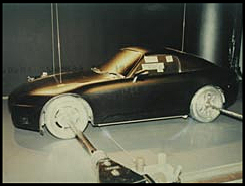FRP is an acronym for Fiber Reinforced Polymer. Some will say that it stands for Fiber Reinforced Plastic, but this is incorrect – Not all plastics are polymers. In the case of Mugen’s manufacturing process, they use a proprietary FRP composite developed in-house after much testing in the lab, wind tunnel and street.
Some of Mugen’s aero pieces are constructed from FRP exclusively; bumper covers, side sills, spoilers. But Mugen manufactures two items from both Carbon Fiber and FRP – Hoods for Fit, and S2000, and S2000 Hardtops. The reasoning is pretty straightforward, Carbon Fiber construction is the strongest, lightest material available for these parts, but it comes at a cost. FRP, on the other hand, offers a lower cost option. While not as strong or light as Carbon Fiber, FRP is still extremely strong and still lighter that most other materials. Most importantly, it can be used in the same molds as the Carbon Fiber pieces, therefore offering the same precise fit that Mugen’s Carbon Fiber parts are known for.
Here are a few common questions regarding Mugen’s FRP parts:
Q: What is the weight difference between the Carbon Fiber and FRP parts?
A: The weight difference is about 25%. For instance, the Carbon Fiber Hood for the S2000 weights 34 lbs – the FRP unit weighs X44 lbs.
Q: How well does the FRP top fit?
A: The fit is perfect, just like Mugen’s Carbon Fiber Top. The same molds are used to produce both.
Q: Does the top come with all of the mounting hardware?
A: All the necessary hardware is included, as is the Polycarbonate rear window.
Q: What is required to get FRP parts ready to paint?
A: All of Mugen’s FRP parts come primed and ready for paint. Your body shop will only need to give them a light scuffing and thorough cleaning.
Q: Should I test-fit my FRP parts first, or can I go ahead and paint them knowing that they will fit?
A: It’ll fit, period. Paint it, install it and enjoy.
Below are some technical data regarding FRP (source: American Composites manufacturers Association):
Not all plastics are composites. In fact, the majority of plastics today are pure plastic, like toys and soda bottles. When additional strength is needed, many types of plastics can be reinforced (usually with reinforcing fibers). This combination of plastic and reinforcement can produce some of the strongest materials for their weight that technology has ever developed...and the most versatile.
Therefore, the definition of a fiber-reinforced polymer (FRP) composite is a combination of :
-a polymer (plastic) matrix (either a thermoplastic or thermoset resin, such as polyester, isopolyester, vinyl ester, epoxy, phenolic)
-a reinforcing agent such as glass, carbon, aramid or other reinforcing material such that there is a sufficient aspect ratio (length to thickness) to provide a discernable reinforcing function in one or more directions.
FRP composite may also contain:
- fillers
- additives
- core materials
... that modify and enhance the final product. The constituent elements in a composite retain their identities (they do not dissolve or merge completely into each other) while acting in concert to provide a host of benefits ideal for structural applications including:
** High Strength and Stiffness Retention - composites can be designed to provide a wide range of mechanical properties including tensile, flexural, impact and compressive strengths. And, unlike traditional materials, composites can have their strengths oriented to meet specific design requirements of an application.
** Light Weight/Parts Consolidation - FRP composites deliver more strength per unit of weight than most metals. In fact, FRP composites are generally 1/5th the weight of steel. The composite can also be shaped into one complex part, often times replacing assemblies of several parts and fasteners. The combination of these two benefits makes FRP composites a powerful material system- structures can be partially or completely pre-fabricated at the manufacturer's facility, delivered on-site and installed in hours.
** Creep (Permanent Deflection Under Long Term Loading) - The addition of the reinforcement to the polymer matrix increases the creep resistance of the properly designed FRP part. Creep will not be a significant issue if the loads on the structure are kept below appropriate working stress levels.
** Resistance to Environmental Factors - Composites display excellent resistance to the corrosive effects of:
** Freeze-thaw: because composites are not attacked by galvanic corrosion and have low water absorption, they resist the destructive expansion of freezing water.
** Weathering and Ultra-Violet Light: FRP composite structures designed for weather exposure are normally fabricated with a surface layer containing a pigmented gel coat or have an ultraviolet (UV) inhibitor included as an additive to the composite matrix. Both methods provide protection to the underlying material by screening out UV rays and minimizing water absorption along the fiber/resin interface.
** Chemicals and Temperature: Composites do not rust or corrode and can be formulated to provide long-term resistance to nearly every chemical and temperature environment. Of particular benefit, is composites ability to successfully withstand the normally destructive effects of de-icing salts and/or saltwater spray of the ocean.
** Fire Performance of Composites - FRP composites can burn under certain conditions. Composites can be designed to meet the most stringent fire regulations by the use of special resins and additives. Properly designed and formulated composites can offer fire performance approaching that of most metals.
